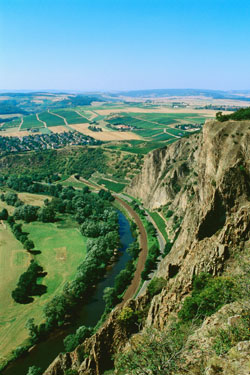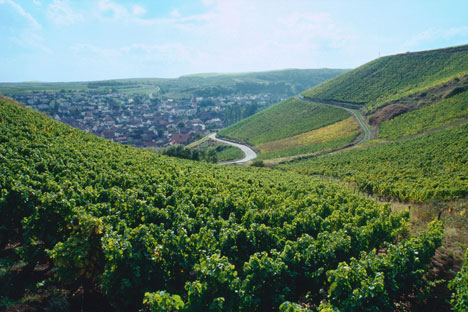The Nahe is a safe bank year after year. Therefore, we assumed that we would find a whole range of excellent wines here this time as well. But what we tasted from this small region far exceeded our expectations. One wine is better than the other. The stylistic differences alone guarantee that one will hardly get bored, but the top wineries also consistently succeed in expressing the character of their sites in all facets. You could spend days tasting the best wines of this vintage side by side to get to the bottom of their subtleties.
 |
| Vineyards at Rotenfels (Photo: DWI) |
The original two top wineries, Dönnhoff and Emrich-Schönleber, have now become four with Diel and Schäfer-Fröhlich, and with the current vintage at the latest, the Hermannsberg estate, which emerged from the Niederhausen-Schlossböckelheim estate administration, a former state domain, also claims a place in the front row.
All of these estates shine this year with brilliant wines that, almost without exception, belong to the top of the vintage in Germany. This time, the Schlossböckelheimer Felsenberg proves to be the outstanding site: both Dönnhoff and Schäfer-Fröhlich have taken outstanding Rieslings from it, both of which, despite their unmistakable stylistic differences, impress above all with their enormous complexity and delicacy. You have to take time for both wines to discover even halfway what they are made of, and we are not sure that they will not become even more fascinating with time.
At Dönnhoff, the Felsenberg is currently even just above the Hermannshöhle, from which by far the finest wines of the estate have come so far. This year, too, this tremendously compelling and at the same time highly elegant Riesling is once again one of the great wines of the vintage, but it is still completely unapproachable. So the last word has not yet been spoken here either.
The beguilingly juicy Goldloch from Schlossgut Diel is much more open-hearted. A truly hedonistic wine that is by no means only superficially convincing. In addition to all its charm and juiciness, the Goldloch also has great complexity, a taut structure and a playfulness that won't let you go for a long time. The Burgberg from the same house, on the other hand, is still completely locked in, extremely mineral, very firm, almost angular. A fortress that can only be insufficiently approached at the moment, even with long aeration.
The Hermannsberg estate, on the other hand, is particularly successful with another wine from a Schlossböckelheim site. The Riesling from the Kupfergrube is one of the best we know from this vineyard with its very fine spiciness, the typical dark berry note and its perfect balance. It even surpasses the (also excellent) example from Schäfer-Fröhlich, whose 2009 edition took the cake last year. Two other wines from Tim Fröhlich, Halenberg and Felseneck, are on an equally high level, and this year he has perhaps bottled his greatest dry wines to date.
 |
| Vineyards near Wallhausen (Photo: DWI) |
Unusually early in the year, we tasted the Monzinger Halenberg and the Frühlingsplätzchen from Emrich-Schönleber. While the latter was already relatively accessible, as always, the Halenberg once again proved to be a safe from which its qualities could only be elicited gradually and hardly completely, even with plenty of air. As with many other Grosses Gewächsen from the Nahe, we would not be surprised if this one, too, could improve with a little bottle maturity.
This would not even be the end of our enumeration of all the first-class wines from the wineries mentioned, but we would rather conclude with one not yet mentioned: Since Prince Michael zu Salm-Salm transferred the management of the Prinz zu Salm-Dalberg winery to his sons Constantin and Felix, the qualities of this ecologically managed winery have increased enormously and are now hardly inferior to those of the top wineries in the region. In 2010, the Grosse Gewächse from the Wallhausen sites Felseneck and Johannisberg are worthy of any attention.
All the current Grosses Gewächse from the Nahe in the wine guide (unfortunately, the Dr. Crusius winery did not take part in the tasting):